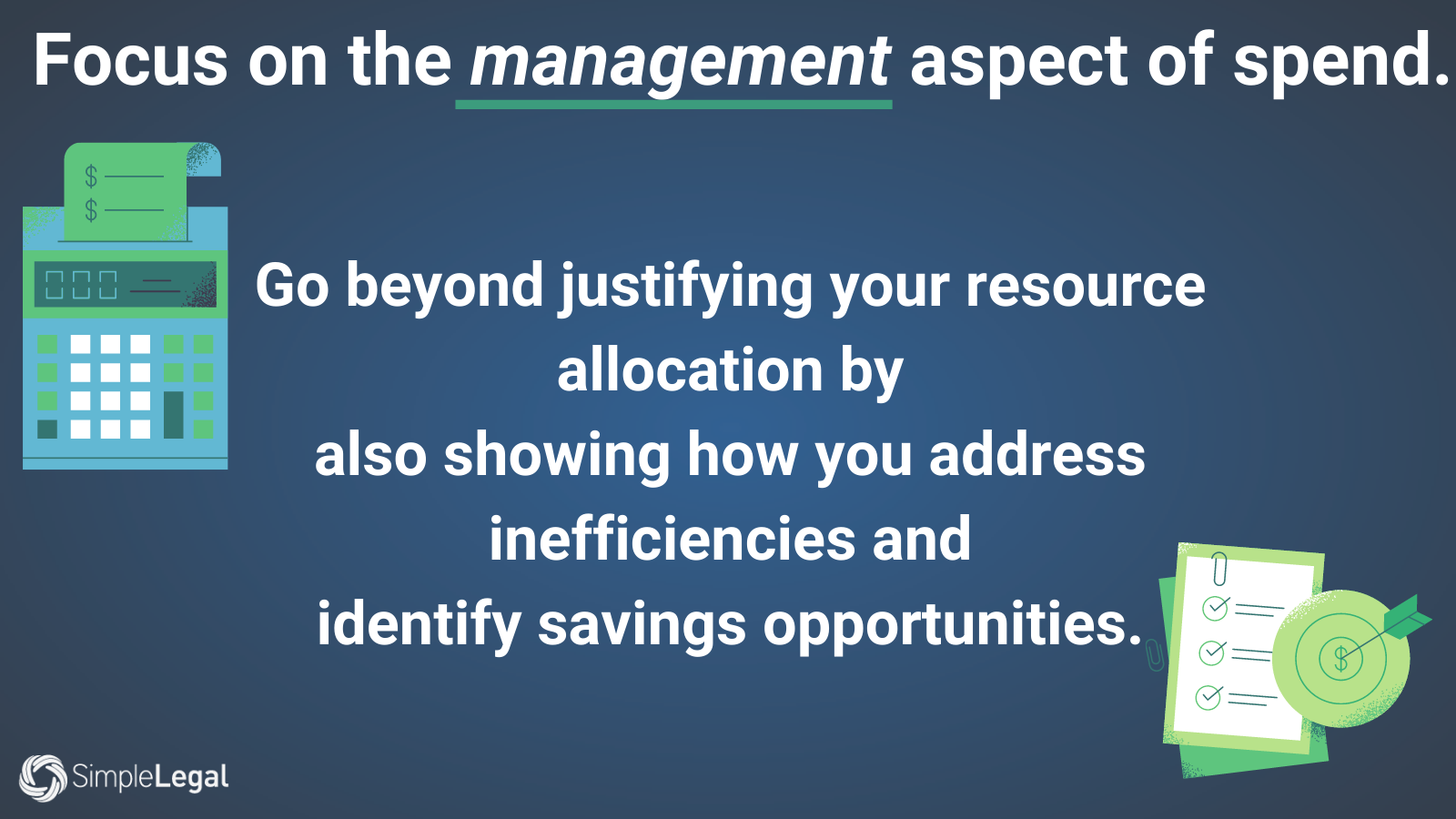Legal ops: it’s time to get serious about proving your value with data

“No matter how brilliant your mind or strategy, if you’re playing a solo game, you’ll always lose out to a team.” — Reid Hoffman, American entrepreneur
You may know exactly where your legal spend is going and why, but that information doesn’t always make its way to other departments, such as finance and accounting. Legal ops supports companies in myriad ways. But if you don’t have a way to share your strategy and contributions with the rest of the company, your legal department is playing a solo game when they could be playing as part of the company’s team.
As the COVID-19 crisis continues to lead to tightened legal budgets, it will become increasingly important for your legal team to justify your legal spend. The solution is simple: crystal-clear clarity. Your team can leverage spend management and hard data to prove your value, build better relationships, secure your budget, and avoid potential downsizing.
Here are three reasons why demonstrating your value matters, and three ways you can use financial data to prove your department’s ROI.
Clarify Your Value Via a Cross-Functional Relationship with Accounting
When it comes to collaborating with finance and accounting, spend management is such a valuable asset. Finance is always looking for explanations of spend and more accurate budget forecasts. With a spend management platform, you can not only provide that data, but you can also show finance just how well you manage your budget.
Start by making your budget more predictable by implementing legal billing guidelines and negotiating more alternative fee arrangements (AFAs) with vendors. You can also show your value by demonstrating what your department does to proactively manage and reduce spend.
For example, when reporting on how much your department spends on outside vendors, you can also highlight how automated enforcement of minimum billing increments reduced costs associated with double billing.
Consider the difference between these hypothetical report highlights:
“In Q3, we increased our legal spend by 11% due to an increase in outside vendor spend. This report includes a breakdown of spend by vendor.”
Now, compare that to the revised version:
“In Q3, we increased our legal spend by 11% due to an increase in outside vendor spend. This report shows the breakdown of spend by vendor. We have highlighted vendors that have agreed to move to AFAs in Q4, which will allow us to more accurately forecast budget needs. We have also updated our billing guidelines to reduce minimum billing increments to .1 instead of .25. We estimate this will reduce hourly invoices by 60% in Q4.”
Both of these summaries start by admitting you overspent your budget by 11%. However, the second example uses data-backed explanations of how you intend to improve budget forecasts and reduce spend in Q4. By going to finance and accounting with details and solutions, you can improve overall collaboration.
With upgraded legal enterprise software, you can automatically track several metrics, including spend by vendor, average timekeeper rate, practice area, percentage of AFAs versus hourly, and much more. Not only does this save you and accounting time, it increases both departments’ overall visibility into legal spend.
You can also enhance collaboration between the departments by integrating the technology you use. Integrations reduce time spent switching between applications, which in turn reduces manual, administrative work such as duplicate data entry.
Connect your e-Billing solution directly with their accounting software to help share information more efficiently. The result will be fewer surprises and easier collaboration when an issue does arise.
Highlight Specific Value-Adds to Secure Future Budget Approvals
People outside of legal don’t always fully understand legal’s role in the company, so you’ll need to present your value in a way that matters to them. Track metrics, like proactive and preventive legal work, to illustrate your department’s efficiency and your contributions to the company as a whole. Reporting also helps you show where your money is going, so you can justify your department’s spending.
Let’s say your company set a goal of increasing internal promotions. You could use business intelligence tools to show HR/people ops how you make data-driven decisions for your department’s staffing needs.
Take a look at this data visualization from Tableau. This particular graph shows 100 entrepreneurs, but you could use this same style to show employee performance. With SimpleLegal’s Tableau add-on, you could create a visual much like this one to show how you identify top performers. You could even integrate data that shows how each employee’s work ties back to revenue for the company. Remember: to demonstrate your value to other departments, you have to speak their language. Focusing on overarching company goals, like work tied to revenue and savings tied to internal promotions versus the cost of onboarding a new hire, will resonate better with HR than legal-specific outcomes.
Use data to make the argument for more funding, approvals, or promotions more palatable. Making this connection is particularly important for legal ops, which is often considered a credence good. It’s challenging to pinpoint the value of credence goods because it’s usually dispersed and indirect. It’s not easy to directly tie money spent to money made.

To make a case for more budget, you’ll need to connect your department’s actions to larger company goals. Prove that your actions directly benefit the organization as a whole and you’re more likely to get additional budget approvals.
For example, suppose you want to hire an internal intellectual property (IP) management expert. In that case, use spend management reports to show that the legal department increased outside vendor spending for IP matters by 50% last year—showing that an internal expert would actually save the department money.
Use Clear Record-Keeping to Sidestep Budget Cuts
The majority of executives surveyed in the 2020 Corporate Legal Operations Report said cost control was a top priority. And as the pandemic forces more companies to trim their overhead, legal spending (as well as other department budgets) is being closely scrutinized. A department that can’t prove its worth is in serious danger of budget cuts, salary reductions, and hiring freezes. Get ahead of shrinking budgets by consistently tracking how your work and spend benefit the company.
For example, if you’ve moved away from legacy systems and invested in upgraded legal tech, keep a record of the benefits so you’re prepared to show the ROI for this move.
Let’s say you’ve harnessed automation to improve accruals management. By tracking how much manual work the tech allows you to automate, you can point to a X% increase in department productivity. You can also compare previous accruals management reports to the newly automated process to show how the tech reduced the discrepancy between accrual estimates and amounts invoiced by outside firms by X%.
In addition, you can show you’re doing your part to boost the company’s bottom line by eliminating any bloat or inefficiencies—and then document it thoroughly. A department with transparent spending and proven efficient use of funds will fare better during a round of budget cuts than one with murky spending habits.
If you’re curious how much money a legal-ops management platform could save you, check out our savings calculator.
To Prove Your Value, Collect the Right Data
The perception that value is a nebulous, difficult-to-prove concept is wrong. You can concretely demonstrate your department’s value using hard numbers. But to do so, you’ll need to start gathering data early—and often.
If you really want to get serious about justifying your department’s value, invest in spend management software. It will help you keep track of where your money is going so you can more accurately demonstrate your department is working at peak efficiency.


